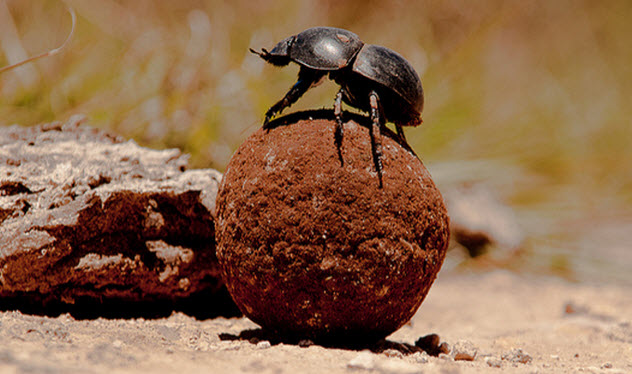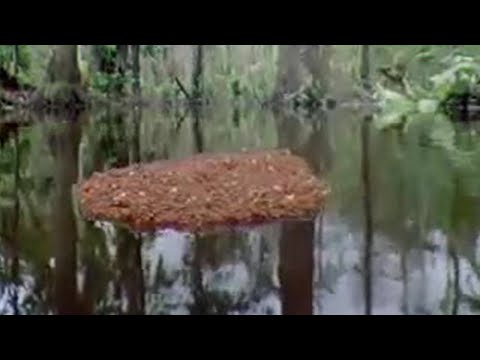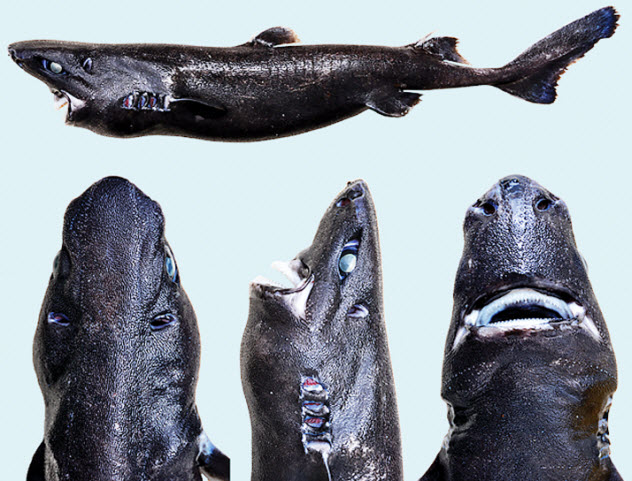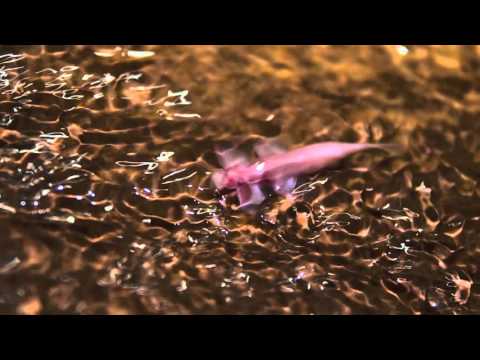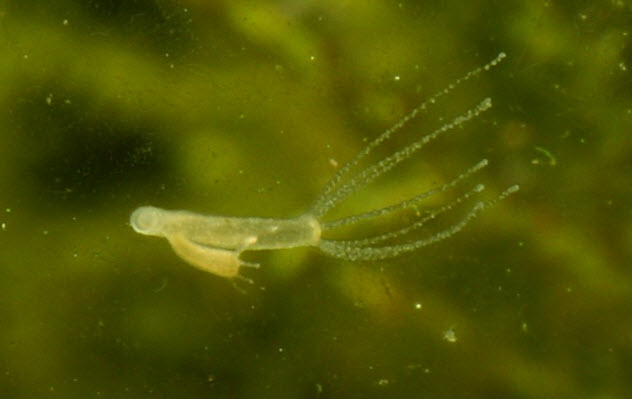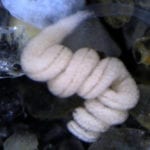10 Face Fish
Think twice before you feel like being mean to the next tropical fish you see. It might just pick you out in a police lineup. A freaky ability has been discovered in fish for the first time—they can recognize human faces. Well, at least one species can. The freshwater archerfish Toxotes chatareus hunts insects above water by disabling them with a spit-stream of water. Using food rewards, the fish were taught to spit at people in the face. Luckily, not real people. A computer screen near their tank allowed the option to choose between two heads. If they spit at the one they’d been taught to recognize, the fish received a treat. They managed to correctly squirt the right face 86 percent of the time. Forget the jokes about three-second memory. The archerfish can remember up to 44 people. Even when major features were deliberately removed or changed, they still did well. This amazing feat is baffling scientists. Unlike domesticated animals, fish have no evolutionary reason to recognize human faces. It is believed that the ability to memorize people’s facial features originates in the neocortex of the brain, a feature present in species such as horses, dogs, and even cows. The archerfish has a tiny brain with no neocortex.
9 Insect Photographer
Don’t expect to see dung beetle paparazzi any time soon. That will just freak Vin Diesel out. But they do love photography—their version of it anyway. Dung beetles do a little dance on top of a poop ball (where else?) during which they mentally take “snapshots” of the sky. Researchers believe that they do this to determine their position and that the dance creates a memory of their geographical and celestial surroundings. Afterward, they drop off the ball and can travel in a straight line. For a long time, it’s been known that insects, dung beetles included, use the light of the Milky Way to find their way. However, the beetles now show more advanced navigational abilities. During their dancing, these bug astronomers create an internal memory of the positions of the Sun, Moon, and stars. They then use this stored image to travel where they want to go. It remains a mystery whether they use any other ways to plot their position. So far, none have been found. They certainly don’t use anything else that would make their lives easier. Even when the sky is completely hidden behind clouds, dung beetles don’t follow landscape cues like most other insects do.
8 Ant Life Rafts
Certain ant species build life rafts out of their own bodies. But that’s old news. What astounded researchers was when they had a second look at this already amazing cooperative display and found that each ant had an assigned seat. When there is a flood, these ants don’t just pile into a random cluster and hope they will safely float out the disaster. In prearranged fashion, they attach to each other using their jaws, feet, and sticky leg pads. Alpine silver ants will assemble around the colony’s queen to ensure her survival by taking the same “seat” each and every time. The discovery happened when researchers painted ants with different colors and then watched which went where. Encouraged by mock floods, the plucky insects remembered their places without fail. Most endearing is how the ants modify rafts when their young are in danger. Building three layers (keeping the eggs and pupae snug in the middle), more worker ants will strengthen the sides along the base and on the top. It’s still a question how positions are decided, but scientists believe it may have something to do with every ant’s size, job description, age, and even personality.
7 Snake Beats Jet
For most, snakes hold a varying degree of the freak-out factor. Poisoned fangs, too many snake-infested horror movies, creepy zombie stares, take your pick. Now there is a new angle to the slithering reptiles, and it’s enough to scare (or fascinate) people even more. Snakes can accelerate faster than fighter pilots. During a study that included both venomous snakes and their friendlier cousins—all right, their cousins that crush things to death—video footage revealed the frightening truth about their speed. For constrictors, they chose 14 Texas rat snakes. Two species of vipers, six western cottonmouths, and 12 western diamondback rattlesnakes also had their attacks filmed. This is what they discovered. Even when wearing a special suit to counteract gravity, a fighter pilot will black out at nine Gs (nine times the force of gravity). With no detectable ill effect upon their scaly bodies, a snake can unleash a strike up to 28 Gs. All the snakes in the study literally struck quicker than a human eyelid can flutter. When provoked, they reached and bit their targets between 50 and 90 milliseconds. It takes us 200 milliseconds to blink.
6 Waterless Tadpoles
These oddities of the frog world live in sand and even nosh on it. The adult frogs are intriguing creatures to watch, with the males performing dancing moves to court females and intimidate rivals. However, the young of Micrixalus herrei, aptly called the Indian dancing frog, remained a mystery—and missing. When they were finally discovered living deep below the soil in rivers, they were truly strange but well adapted to their environment. The tunneling tadpoles look more like flat eels with muscular tails that help them dig through silt and gravel. Burrowing is highly unusual for frogs during this developmental stage, but these frogs are experts. A sheath of skin protects their eyes from getting damaged while navigating their pitch-black world. They are ribbed, a rarity that exists in only four other species (though not so young), but it makes sense in this case. A better framework provides stronger muscles to wiggle through the earth and protect them from soil pressure. What really makes them unbelievable is how they digest their food. After they suck sediment and decaying organic matter through filtered jaws, their meals are processed with the help of special organs in their guts—minute bags filled with limestone.
5 Glow-In-The-Dark Shark
A new nightmarish shark has been found off the Pacific coast. Totally black and living as deep as 1.6 kilometers (1 mi) underwater, it also glows. Due to its black outfit, stealthy manner, and bioluminescent tendencies, scientists creatively called it the Ninja lanternshark. This shining wonder is the latest to join other lanternsharks that are already lighting up the oceans, about 40 species of them. Their soft blue glow comes from small, cup-shaped organs called photophores, of which the latest lanternshark has significantly fewer. Where the other species have photophores covering their entire undersides, the Ninja merely has a few around the head. A disembodied glowing head cutting through the murky depths of the oceans is enough to give anyone chills, but surely, there must be a reason why the new guy glitters differently. Nobody knows—not even why other lanterns have glowing bellies or why there are even sharks that glow. The usual suspects include that they use their luminosity to attract prey in the dark, to hide their shadows from prey below, and possibly even to communicate.
4 Climbing Cave Fish
There is a species of cave fish that can “walk” with its pelvis, something unique in the world of fish. Cryptotora thamicola completely lacks eyes, but it is an avid traveler. With a stiff, rocking motion, they go up waterfalls and even over rocks where there’s little water. The way they use their pelvises is very similar to walking and not wriggling. It’s completely different from other “walking” fish such as mudskippers, walking catfish, and lungfish that use their tails and fins to move over land or riverbeds. Incredibly, its pelvic bones have more in common with animals that walk on four legs. This is because they share another major characteristic—a backbone where vertebrae are locked together with stiff supports. It’s the last pelvic structure one would expect because fish require flexible spines to shimmy through the water. This unusual cave fish could be a missing link living in real time. Cryptotora is the first evidence of an ancient starting point from which four-legged animals evolved to move around as they do today. Why this cave fish rejects the safety of pools for epic treks up fast rivers and steep rocky areas remains unsolved.
3 Texture-Changing Frog
A new frog discovered in the Andes is displaying a really weird trait. Move over, chameleons, the competition just did one better. When it comes to novel camouflage, this new hopping wonder changes texture. During a night search in 2009, a frog so spiny that it earned itself the nickname “punk rocker” attracted the attention of researchers. When they peeked at it the next day, they got the surprise of their lives. Gone were the spines, and the frog’s skin was as smooth as the cup that held it. Confused, the researchers thought that somehow the frogs had been switched. The researchers put moss in the container, and unbelievably, the spines returned within minutes. It appears that these frogs are particularly skillful at pretending to be a clump of moss, something that fills their habitat. The ability to shape-shift like this has never before been displayed by any amphibian. While it’s mind-boggling to watch it steal the texture of whatever it is sitting on, the frog is messing with how researchers identify species. Especially those known from only a few preserved samples that might also have had this hidden ability to look like two different frogs. Or five.
2 Tearing New Mouths
Put lunch away before reading this one. The most cringeworthy mouth in the animal kingdom doesn’t belong to the shark in Jaws but to a creature with no mouth. Hydra vulgaris is a freshwater creature that has no bones and resembles a tube 1.3 centimeters (0.5 in) in length. At one end, it also has a set of barbed tentacles used to paralyze prey. As if its looks aren’t weird enough, the hydra tears itself a new maw whenever it feels like a snack. It rips open the skin of its head, swallows its paralyzed prey, and then does something that scar-haters would kill for. It seals the mouth again without any trace that it had ever existed. If that sounds horrific, it’s even worse at the cellular level. Scientists theorized that this dramatic ability could only happen because the hydra somehow rearranges its cells. Instead, they discovered the transformation was so extreme that it was deforming, not rearranging, the cells right down to their nuclei. Yet the hydra rips mouth after temporary mouth with no ill effect.
1 Immortality
Hydras return—this time grasping the key to immortality in their tiny tentacles. Unlike humans, hydras constantly regenerate their bodies with stem cells. These wonderful cells can divide constantly and become any type a body needs—perfect for renewal and healing. When biologist Daniel Martinez heard about the hydras’ supposed deathless potential, he set out to disprove it. The project involved pampering almost 2,300 hydras by keeping them in peak water conditions and feeding quality meals to every individual. This was to see if any keeled over even when every need was being met. If the hydras had no ability whatsoever to exist until kingdom come, advancing age would decrease their fertility and heighten the death rate. Eight years of princess treatment went by. Each year, about 1 in 167 hydras died while 80 percent of the rest flourished and showed no drop in fertility. Even though there was death—and in the wild, most will die from predators and environmental factors—the study showed that hydras show no signs of aging under ideal conditions. In fact, certain individuals may live forever. Read More: Facebook Smashwords HubPages

